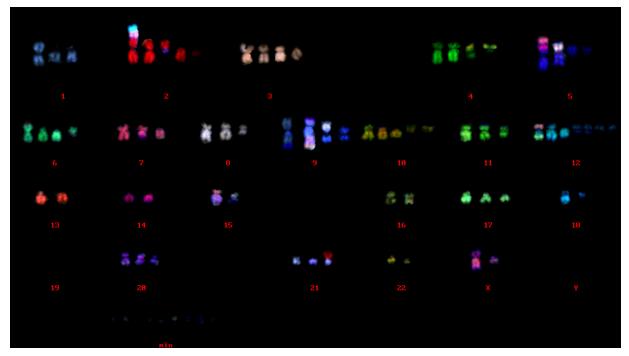Nucleic acid probes can be labeled with tags or other modifications during synthesis. Many reagents are available for quick and efficient oligonucleotide labeling, and they are most useful for making small amounts of probe or when many different probes with the same label are required. The choice of method depends in part on the extent of labeling required and whether the modification will cause steric hindrance that prevents the desired interactions.

Types of Probe Labeling
Probe labeling is a technique to incorporate a detectable tag in the nucleotide sequence. It allows us to know if the target sequence is present or not. Based on the requirements, common types of probe labeling include radioactive, biotin, enzymatic, chemiluminescent, and fluorescent labeling.
1) Radioactive labeling
Nucleic acid probes can be labelled with radioactive isotopes (e.g., 32P, 35S, 125I, 3H). Detection is by autoradiography or Geiger–Muller counters. Radiolabeled probes used to be the most common type but are less popular today due to safety considerations as well as cost and disposal of radioactive waste. However, radiolabeled probes are the most sensitive as they provide the highest degree of resolution currently available in hybridization assays.
2) Biotin labeling
Biotin labeling can be detected with avidin or streptavidin, which have a high affinity for biotin. Since the reporter enzyme is not conjugated directly to the probe but is linked to it via a bridge (e.g., streptavidin-biotin), this type of nonradioactive detection is known as an indirect system.
Generally, biotinylated probes work very well, but because biotin is a ubiquitous component of mammalian tissues and because biotinylated probes tend to adhere to certain types of nylon membranes, high levels of background may occur during hybridizations. These difficulties can be avoided by using nucleotide derivatives including digoxin 1-UTP, -11-dUTP, and -11-ddUTP, and biotin-11-dUTP or biotin-14-dATP.
3) Enzymatic labeling
In the enzymatic labeling technique, an enzyme or protein can be incorporated into the probe which when reacts with the substrate, gives a signal for hybridization.
In the enzymatic labeling technique, an enzyme is attached to a probe and its presence is detected, usually by reaction with a substrate that changes color. Examples of enzymes used include alkaline phosphatase and horseradish peroxidase (HRP). In the presence of peroxide and peroxidase, a chromogenic substrate for HRP, forms a purple insoluble product. Enzymatic labeling is less advisable, as having less specificity.
4) Chemiluminescent labeling
In this method, a chemiluminescent chemical is attached to a probe and detected by its light emission using a luminometer. Chemiluminescent probes (including the enzymatic labels mentioned above) can be easily stripped from the membrane, allowing the membranes to be reprobed many times without significant loss of resolution.
5) Fluorescent labeling
In this technique, a fluorescent dye is attached to the 3' end of the probe. After hybridization, the released fluorescence can be detected using a fluorescence microscopy or scanner. Common fluorescent dyes, used for probe labeling are Cy3, Cy5 and fluorescein isothiocyanate (FITC).
An amazing application of fluorescent probes is that they can detect multiple sequences using multiple differently colored probes in a single reaction (Multicolor FISH).
Methods for Labeling of Probes
There are four basic methods for labeling nucleic acids. These are:
1) Nick Translation
Nick translation is one method of labeling DNA, which uses the enzymes pancreatic Dnase I and Escherichia coli DNA polymerase I. The nick translation reaction results from the process by which E. coli DNA polymerase I adds nucleotides to the 3'-OH created by the nicking activity of Dnase I, while the 5' to 3' exonuclease activity simultaneously removes nucleotides from the 5' side of the nick. If labeled precursor nucleotides are present in the reaction, the preexisting nucleotides are replaced with labeled nucleotides. For radioactive labeling of DNA, the precursor nucleotide is an [α-32P] dNTP. For nonradioactive labeling procedures, a digoxigenin or a biotin moiety attached to a dNTP analog is used.
2) Random oligo primed synthesis
Random-primed labelling of DNA fragments was developed as an alternative to nick translation to generate uniformly labelled probes. Double-stranded DNA is denatured into single strands and annealed into random hexamer oligonucleotides. The oligonucleotides serve as primers for the 5' to 3' polymerase, which synthesizes labeled probes in the presence of a labelled nucleotide precursor.
3) End labeling
In this technique, probe is isolated and end labeled by removing the 5'-terminal phosphate using alkaline phosphatase first and adding a 32P-labeled phosphate with the help of a kinase. End labeled probes are far less labeled than the transcribed ones with labels at several nucleotides in the strand.
4) PCR labeling
A straightforward and now very popular method of incorporating labeled nucleotides into a probe. Design primers that will amplify a sequence you wish to use as a probe, and simply include a labeled dNTP during PCR.